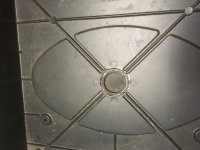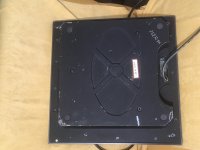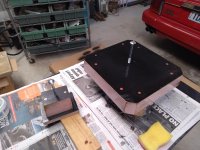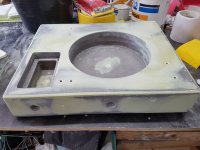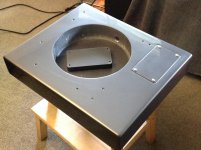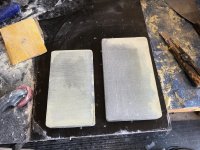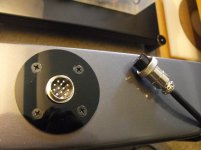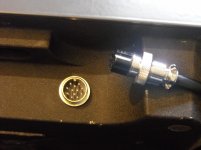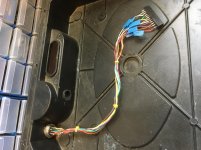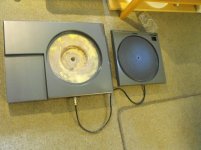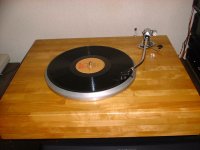The choice of upgrading to a top level moving coil from mid-level moving coil or addressing the structural isolation issue in a definitive way, was easy to make. The costs were about the same. In the context of tonearms, phono stages, interconnect, platter mats, it seems a reasonable way to go. I'm still saving for the cartridge (a consumable item!!)Good choice. It does suprise me that many people spend a fortune on a front end but poo poo something like a minus-k. SP-10 owners on the whole seem more open to the idea of a 'pro' vibration isolation solution. I wish I could afford one.
Pitrus brings up a good question that I've thought about for years. My intent, when my SP-10 restoration comes to the front of the queue is to put a box around the plinth / table, etc., with the hinged parts being clear but fairly substantial. I don't see why one would make the world's most vibration-absorbing/dissipating plinth and then do nothing to control airborne (or airbourne...) noise.
I have pondered this too. I may try some measurements once I get a TT up and running (Sold my disappointing RP8). With my RP8 and Apheta 2 with amp volume turned down I could hear the music coming off the cartridge/arm at 1m from the TT.
Thinking out loud here - The internal dimensions will be critical as too will the damping. Otherwise you could setup standing waves inside the cover and/or end up with a cavity oscillator. Think speaker enclosure design, albeit with far lower SPL levels.
Last edited:
Somewhere in the distant past I remember some info, perhaps an AES paper, with some info/data on the topic. Yes, the cavity inside could have a resonance or two, but if the exterior sound level is greatly attenuated by the cover, most of the heavy lifting is done (no intended pun about the weight of said dust cover). Also, it might be handy to have a deionizer inside to get rid of static.
Too many ideas/theories; not enough time.
Too many ideas/theories; not enough time.
I love where this thread is going. So many comments related questions I have puzzled over many times.The SP10 has vanishingly low level of rumble. I have seen no before and after rumble measurements to verify this theory.
I tend to agree, anything that can let vibration out can also let vibration in. So if the deck is not well isolated the bearing drain could infact increase rumble.
One thought I did have was that the bearing drain stabilized the whole motor in the chassis.
There seem to be two schools of thought related to self generated vibration: to drain or to damp. The mkII bearing is freely suspended and Technics make certain of this by removing a hole in the chassis base and replacing it by a thin rubber membrane. I suggest that this flexible membrane decouples the thrust bearing interface from the chassis base container, which could act as a resonator.
Minimising self generated noise is a different problem to isolation from external vibration. To add to Warrjon's comment above, anything that can block vibration entering, will also block vibration leaving. Therefore any bearing drain energy cannot exit through the minus-k (or any other effective isolator). The supplier of the minus-k pointed out to me that when he supplies the minus-k for digital transports, he also supplies a heavy constrained layer damping sheet to deal with the self generated transport vibration.
In my rigs, any self generated noise is sunk into the massive damped bentonite plinth.
Attachments
I can add a testimony even if perhaps not very important; a dear friend who works as a doctor and a former owner of an SP10 II heard the sound of his SP10 engine when it was running, stating that it was almost inaudible, the same test he did on his new SL 1200 G and also in this case the engine noise was at the same level as the SP 10II.
What does all this teach?
What does all this teach?
@Bon
Good post.
In terms of getting vibration away the most extreme I have seen - by my Mentor in such matters - was a 5" diameter x 60" carbon rod sunk into the concrete on which the house floor floated! The TT's weight was mainly supported by the main bearing of the TT as I describe in my earlier post. From my Thorens 124 days I have used this bearing-support concept (bearing to shelf) and have had no problems and cleaner sound.. I always used a reinforced wall bracket as the plinth shelf.....but my present home has - effectively - a timber frame construction and a wall bracket stand does not give adequate rigidity. [Between plinth mount points and the 'shelf' I use has a copyright 'base' which I am honour bound to leave undescribed as the guy who designed it has commercial interests.
I house all of my system in a cupboard built for purpose in the room next door to my listening room and the speaker leads run through the dividing wall at floor level. Also, the floors are floating in that there is no physical contact with the walls. [Nor does the TT / other sources have contact with any wall.] Although I am no liker of very loud bass heavy music, I can say that with this set up even a pair of (in temporary use) elderly Magnaplanar .5 panels have a dead clean bass even in heavy passages of classical full orchestral music....not that I listen to much of that either! I commend the 'kit next door' approach...and if you have a cupboard (even a 'mock cupboard) covering the system support your Missus will love you to bits!😉 Incidentally those old Maggies are much underrated speakers properly driven.
Good post.
In terms of getting vibration away the most extreme I have seen - by my Mentor in such matters - was a 5" diameter x 60" carbon rod sunk into the concrete on which the house floor floated! The TT's weight was mainly supported by the main bearing of the TT as I describe in my earlier post. From my Thorens 124 days I have used this bearing-support concept (bearing to shelf) and have had no problems and cleaner sound.. I always used a reinforced wall bracket as the plinth shelf.....but my present home has - effectively - a timber frame construction and a wall bracket stand does not give adequate rigidity. [Between plinth mount points and the 'shelf' I use has a copyright 'base' which I am honour bound to leave undescribed as the guy who designed it has commercial interests.
I house all of my system in a cupboard built for purpose in the room next door to my listening room and the speaker leads run through the dividing wall at floor level. Also, the floors are floating in that there is no physical contact with the walls. [Nor does the TT / other sources have contact with any wall.] Although I am no liker of very loud bass heavy music, I can say that with this set up even a pair of (in temporary use) elderly Magnaplanar .5 panels have a dead clean bass even in heavy passages of classical full orchestral music....not that I listen to much of that either! I commend the 'kit next door' approach...and if you have a cupboard (even a 'mock cupboard) covering the system support your Missus will love you to bits!😉 Incidentally those old Maggies are much underrated speakers properly driven.
Last edited:
I borrowed Bon's idea of making inserts for the motor and arm.
These are made from form ply and MDF the motor insert is 60mm and the tonearm is 100mm to go all the way through the plinth. They are cut with a 2° taper to aid in plug removal.
To finish the plugs they are screeded on the edge with body filler, sanded smooth and coated with 2K polyurethane varnish (Wattle 7008), I have used this varnish successfully in many laminating molds
I spoke to the supplier of the isophthalic resin I bought and they recommended not using less than 1% catalyst and doing a maximum of 10mm thick pours. This is un-waxed resin so I will not have to sand between pours if they go over multiple days.
These are made from form ply and MDF the motor insert is 60mm and the tonearm is 100mm to go all the way through the plinth. They are cut with a 2° taper to aid in plug removal.
To finish the plugs they are screeded on the edge with body filler, sanded smooth and coated with 2K polyurethane varnish (Wattle 7008), I have used this varnish successfully in many laminating molds
I spoke to the supplier of the isophthalic resin I bought and they recommended not using less than 1% catalyst and doing a maximum of 10mm thick pours. This is un-waxed resin so I will not have to sand between pours if they go over multiple days.
Attachments
Minimising self generated noise is a different problem to isolation from external vibration.
In my rigs, any self generated noise is sunk into the massive damped bentonite plinth.
I am also in the damping camp, so my plinth will not have a bearing drain.
Seismic isolation is by far the easiest to isolate with springs (LP12 Pink Triangle) or other methods that provide isolation below 5Hz., the lower the better.
Airborne vibration is another matter altogether, and far more difficult to deal with. most hoods will attenuate higher frequencies but low frequencies can and will penetrate depending on the thickness of the lid.
High frequencies have far less energy than lower frequencies. To attenuate low frequency airborne the lid/enclosure will need to be thick with a gap between the inner and outer shell.
Now comes my issue. The Apheta 2 on an RB808 made music clearly audible upto 1m away from the TT, I could understand the words, and still hear the music at the listening position, all this with the speaker volume turned down. Enclosing this will cause the energy to build up inside the enclosure. To what extent this will effect the music I do not know, I never measured it. I gave up and sold the RP8.
I am in the situation where I have down sized and have a very small house so the TT HAS to sit between the speakers. I have OB speakers so the TT is lined up at 90° between them, where there is the least amount of energy.
.
Imitation is the best form of flatteryI borrowed Bon's idea of making inserts for the motor and arm.
You will have to make armboards. I suggest you layer them up from chopped fibreglass and resin. They will then be hard as rock (glass?). Then you can torque down your tonearm minimising the risk of cracking. Also cut them to a slight taper. It will require care to machine the tonearm hole.These are made from form ply and MDF the motor insert is 60mm and the tonearm is 100mm to go all the way through the plinth. They are cut with a 2° taper to aid in plug removal..
1% catalyst is perfect if you have the patience to wait a week for the cure. I don't see the need to pour in layers if you use casting resin. It is designed for casting figurines, garden ornaments etc. I have never has a problem using it in 90mm thick pours (1% catalyst/resin). You just need a big flexible poly bucket (30-40L) and a stubby garden shovel for mixing.I spoke to the supplier of the isophthalic resin I bought and they recommended not using less than 1% catalyst and doing a maximum of 10mm thick pours. This is un-waxed resin so I will not have to sand between pours if they go over multiple days.
Attachments
I have just read a number of RP8 reviews. Hmm. If you pursue stiffness and low mass above all else, it seems to me you end up with an excellent tweeter. I am not surprised that the "needle talk" was a deal breaker for you.Now comes my issue. The Apheta 2 on an RB808 made music clearly audible upto 1m away from the TT, I could understand the words, and still hear the music at the listening position, all this with the speaker volume turned down. Enclosing this will cause the energy to build up inside the enclosure. To what extent this will effect the music I do not know, I never measured it. I gave up and sold the RP8.
.
1% catalyst is perfect if you have the patience to wait a week for the cure. I don't see the need to pour in layers if you use casting resin. It is designed for casting figurines, garden ornaments etc. I have never has a problem using it in 90mm thick pours (1% catalyst/resin). You just need a big flexible poly bucket (30-40L) and a stubby garden shovel for mixing.
I have a 3/4 of 20kg drum of laminating resin and it's exothermic reaction is different to casting resin, this is why I spoke to the manufacturer of the resin. 10mm pours was their recommendation. Because the resin is un-waxed it will remain sticky on top so I do not have to prep the surface for each pour.
I'll see how I go after the first pour, I'd rather go slow and not have to redo it again.
Time is something I have in abundance. Semi retired. The only place within 300km I can buy casting resin is Bunnings and it's $40/kg
.
I have just read a number of RP8 reviews. Hmm. If you pursue stiffness and low mass above all else, it seems to me you end up with an excellent tweeter. I am not surprised that the "needle talk" was a deal breaker for you.
The RP8 was detailed, it just lacked that vinyl magic I had with the LP12 (my previous TT). and nothing I did made it work for me. So I bought an SP10, EPA-100 and EPC-100 & 205C and headed down this road, or should I say HOLE.
I forgot to write that the owner of both the SP10II and the SL 1200GR used a stethoscope placed in several points of the frame to listen to the noise of the motor when it rotates and the noise was practically unlistenable and very silent; this means that both the SP10II and the 1200GR can be on the same level of quality although there is a design difference of 40 years and that the frame of the SP10 that of the SL 1200GR do not absorb vibrations from the engine.
I have always considered the chassis of the mkII to be its weakest link. It is quite a thin aluminium casting and rings strongly when isolated.I forgot to write that the owner of both the SP10II and the SL 1200GR used a stethoscope placed in several points of the frame to listen to the noise of the motor when it rotates and the noise was practically unlistenable and very silent;
I have a number of back-up mkII's and it has been a long term project to dispose of the chassis and mount the superb motor directly into a well damped plinth. This leaves the electronics in the original chassis which now is a (rather ugly) control box connected by an umbilical. I never compared the stock chassis to the motor+plinth only but I will pull out the stethoscope for a test. The friction brake and strobe are no longer useable but not missed.
I found a similar rebuild by Artisan Fidelity, using panzerholz.
Technics Sp10Mk2 NG — Artisan Fidelity
No price quoted but based on other prices on their site, expect a shock. My materials cost a few hundred dollars. The cast resin-bentonite plinth is achievable by a competent diy-er whereas machining panzerholz is not in reach of my facilities.
Attachments
I have always considered the chassis of the mkII to be its weakest link. It is quite a thin aluminium casting and rings strongly when isolated.
I have some butyl sound deadening left over from my car resto I was going to add a little of this to the inside of the chassis to dampen it.
But I would be interested in your opinion on how the de-chassised SP10 compares to the stock, maybe the next project.......
@bon
@warrjon
Do you know the Kaneta project?
Yes? Ok no problems.
No? So I tell you that this passionate and technical madman developed many years ago what Bon illustrated and explained in the previous intervention.
enjoy the reading
?????????????????????
@warrjon
Do you know the Kaneta project?
Yes? Ok no problems.
No? So I tell you that this passionate and technical madman developed many years ago what Bon illustrated and explained in the previous intervention.
enjoy the reading
?????????????????????
....post no. 178! A few years ago.
In short the TT was 'lost' for dome years...and I now have it back.
I am doing likewise...here is my mock up prior to making a high mass version in metal.
The electronics are now in the case to the left.
The other finished fruitwood plinth is a Kaneta pic from the doc linked above.
In short the TT was 'lost' for dome years...and I now have it back.
I am doing likewise...here is my mock up prior to making a high mass version in metal.
The electronics are now in the case to the left.
The other finished fruitwood plinth is a Kaneta pic from the doc linked above.
Attachments
Last edited:
Nice Job on the refurb. These tables look like they were left outside to get so much corrosion.
I am Lucky to have LAB-500 with Direct Quartz drive and fully automatic features.
@bon
@warrjon
Do you know the Kaneta project?
Yes? Ok no problems.
No? So I tell you that this passionate and technical madman developed many years ago what Bon illustrated and explained in the previous intervention.
enjoy the reading
?????????????????????
That was quite a read, thanks!
Busy on amps at this time! Also blew up my best speakers so am rebuilding those now I have the drivers...also making a tonearm (twin pivot) for the SP-10. Have only got an old Zenith which needs new bearing cones, so that is not much use until overhauled. In other words, it will be a while longer.
Which part of Italy are you living in? I know quite a few people in Italian high-end.
Which part of Italy are you living in? I know quite a few people in Italian high-end.
- Home
- Source & Line
- Analogue Source
- The Incredible Technics SP-10 Thread
